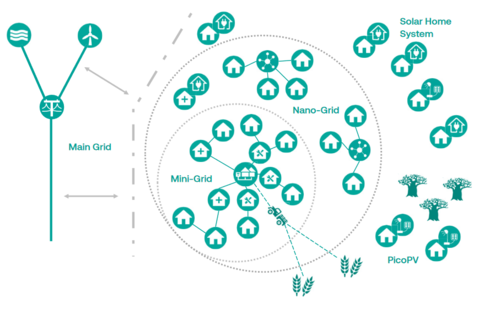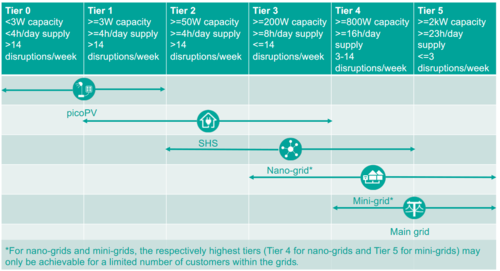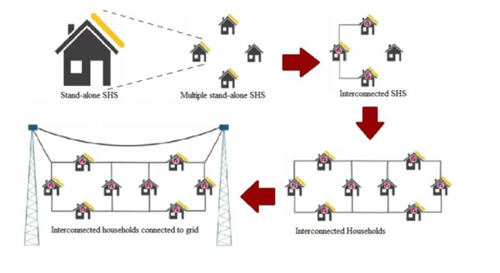Knowledge fuels change
For over a decade, Energypedia has shared free, reliable energy expertise with the world.
We’re now facing a serious funding gap.
Help keep this platform alive — your donation, big or small, truly matters!
Thank you for your support
Nano/Mini-Grids : Definição
Introduction

Along with grid-densification and access to solar home systems (SHS), one of the most important measures to achieve country-wide electrification in Mozambique by 2030 is through the development of mini-grids. The mini-grid market for private sector is still small in Mozambique. Regulatory restrictions limit the participation of the private sector to develop mini-grid projects. Unlike the market for Solar Home Systems (SHS) and Improved Cookstoves (ICS), which are targeted at individual users, namely a household or institution, mini-grids provide access to electricity to a larger number of end-users simultaneously.
There are different solutions for achieving off-grid rural electrification such as stand-alone solutions, nanogrids, mini-grids etc. and are explained in detail below:
Stand-alone Solutions, Solar Home Systems
They supply electricity to a single family and have a capacity of a few kWp. For more information about the market landscape for SHS in Mozambique, please refer to this article.
Mini-Grid
They supply a few kW of electricity to multiple consumers, such as communities, hospitals, schools, etc[2]. They can be powered by different renewable sources such as solar, hydro, wind or hybrid (e.g. solar mini-grids coupled with diesel generator).
The newly published Regulation for Energy Access in Off-Grid Areas (approved by Decree n. °93/2021) from 2021 categorises mini-grids in the following manner:
1. Category 1: mini-grid with an installed capacity ranging between 1 MW and 10 MW
2. Category 2: mini-grid with an installed capacity ranging between 151kW and 1 MW
3. Category 3: mini-grid with an installed capacity under 150kW[3].
Mini-grids are often cost and technology intensive and there needs to be enough electricity demand from the community to meet the O&M cost of the mini-grid for long-term sustainability. SHS on the other hand, usually meet demands of a single family and the electricity supplied is usually enough for a couple of activities like lighting, phone charging, watching TV, listening to radio etc. Thus, there exists a gap between the demand for electricity, which is not meet by SHS but is too small for a mini-grid to be constructed; this is where nanogrids play a role.
NanoGrid
There is no standard definition for nano-grids and different organization use different definitions. According to Energising Development, nano-grids are usually defined in the range between 500 Wp to 10 kWp and cover Tier 2 or Tier 3 of electrical loads of few households as shown in Figure below[1].

Swarm electrification

This concept was first introduced by researchers from TU Berlin and is based on the concept of interconnecting existing stand-alone infrastructures (eg. SHS) to create a small low-voltage DC grid (LVDC). The parties connected to the LVDC are prosumers i.e. they not only consume electricity but also feed it to the LVDC. Compared to the national grid or a mini-grid solution, swarm electrification is a step-wise approach where the LVDC can be expanded organically to connect more people as the demand increases and ultimately connect to the national grid. As the energy demand/supply increases, there is also an opportunity for powering productive uses with the swarm grid. The LVDC is usually owned by the community and the electricity generated is traded among the community members. A swarm grid can be powered by both renewable and hybrid sources such as diesel and are less complex compared to mini-grids.
ME Solshare is one of the companies which is piloting swarm electrification in rural areas of Bangladesh. The company has built a microgrid with a peer-to-peer trading platform for trading electricity among the users such that SHS users can sell excess electricity to non-SHS users. This has dual benefits:
1) SHS users have increased earning by selling excess electricity to the swarm grid
2) both poor households without SHS as well as SHS household with excess demand can buy electricity from the swarm grid[5].
Further Information
References
- ↑ 1.0 1.1 1.2 EnDev, ‘Tiers, Markets, Sustainability: Trends in Rural Off-Grid Electrification’, 2021, https://endev.info/wp-content/uploads/2021/07/EnDev_Learning_and_Innovation_Agenda_Rural_Electrification.pdf
- ↑ Mini Grids - Energypedia.Info’, accessed 19 July 2021, https://energypedia.info/wiki/Mini_Grids#cite_note-EEP_Africa.2C_2018-9
- ↑ ‘Decreto-NÂo-93-2021-de-10-de-Dezembro-de-2021-Aprova-o-Regulamento-de-Acesso-Ã-Energia-Nas-Zonas-Fora-Da-Rede.Pdf’, accessed 19 January 2022, https://amer.org.mz/wp-content/uploads/2021/12/Decreto-nA%CC%82o-93-2021-de-10-de-Dezembro-de-2021-Aprova-o-Regulamento-de-Acesso-A%CC%83-Energia-nas-Zonas-Fora-da-Rede.pdf
- ↑ Mini Grids - Energypedia.Info’, accessed 19 July 2021, https://energypedia.info/wiki/Mini_Grids#cite_note-EEP_Africa.2C_2018-9
- ↑ ME Solshare (2022). https://solshare.com/



















